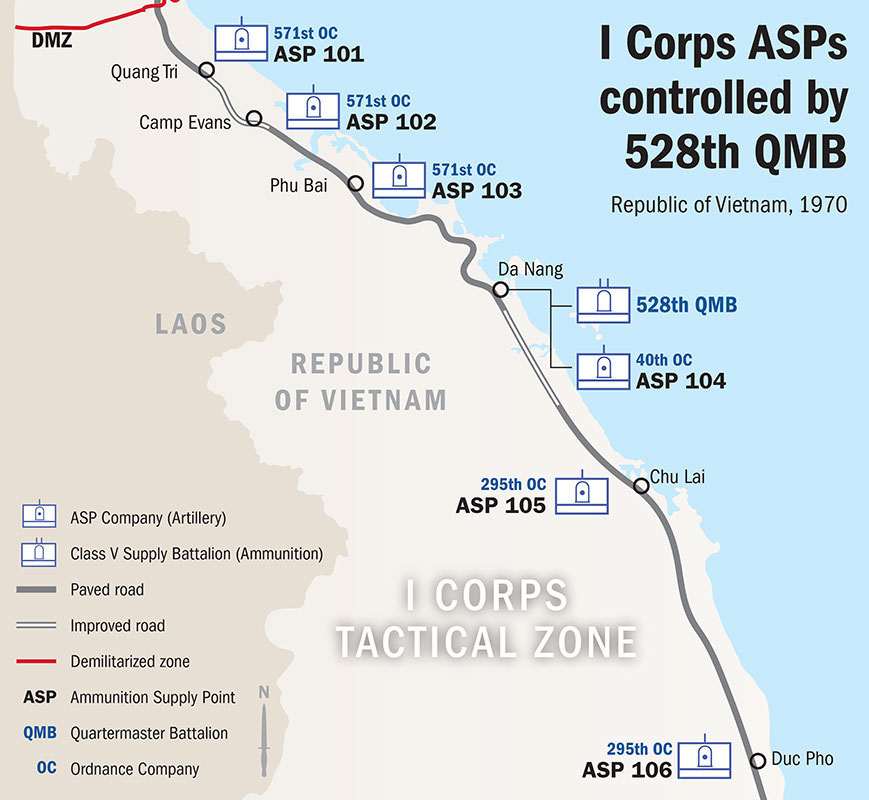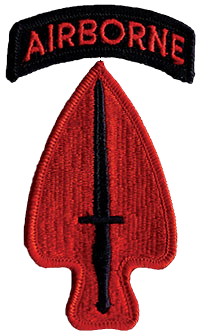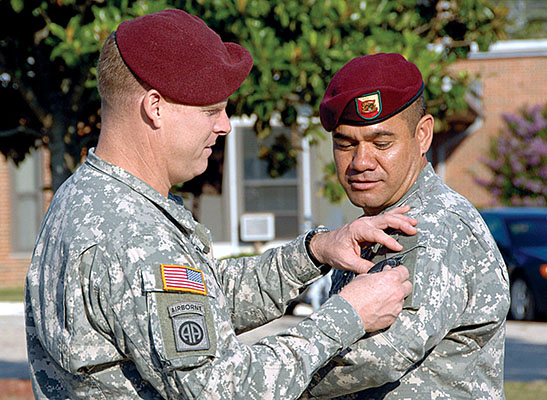DOWNLOAD
On 16 December 2008 Lieutenant General John F. Mulholland approved the redesignation of the Sustainment Brigade (Special Operations) (Airborne) (Provisional) as the 528th Sustainment Brigade (Airborne). While the designation is new, it is only the latest step in the unit’s evolutionary history of providing support to Army Special Operations Forces. This article provides a short historical primer on the 528th Sustainment Brigade. A secondary purpose is to solicit historical campaign vignettes from former and current ARSOF support soldiers.1 The lineage and honors of the 528th Sustainment Brigade (Airborne) stretches back to World War II.
The 528th Quartermaster Service Battalion was activated on 15 December 1942 at Camp McCain, Mississippi. Trained as a non-divisional service battalion, the 528th could use its four companies (each with 160 soldiers) as a manual labor force for a wide variety of missions: transportation and distribution of supplies (Classes I, II, III and IV; food, clothing and equipment, petroleum and general supplies), operation of supply depots, and supervision of civilian or prisoner of war labor. After its initial training, the unit supported the invasion and campaign in Sicily, as part of Lieutenant General (LTG) George S. Patton’s Seventh Army. Transferred to the Fifth Army in Italy, the 528th provided combat service support to the Allied forces as they moved up the Italian “boot.” The 528th Quartermaster Battalion’s service on the Italian peninsula ended with the liberation of Rome.2

On 15 August 1944, seven Allied combat divisions conducted a combined amphibious and airborne invasion of Southern France (Operation DRAGOON). The 528th was among the myriad of support units involved in the invasion and subsequent move north. As a service unit the 528th Quartermaster Battalion unloaded supplies and supported units throughout the U.S. VI Corps area, and continued to support the VI Corps and other Seventh Army units for the remainder of the war. By the end of World War II, the 528th had earned six campaign streamers, to include two with arrowheads for assault landings in Sicily and Southern France. After the war the battalion served in the Army of Occupation in Germany until deactivated in 1947 in France. For the next twelve years the battalion was in an organizational limbo. It underwent several redesignations, inactivations, and activations, in both the active and reserve forces, as a quartermaster and transportation unit.3 The Vietnam War brought the unit back on the active rolls.

Beginning a new chapter in its history, the 528th Quartermaster Battalion was reactivated on 25 September 1969 at Phu Bai, in the Republic of South Vietnam. Organized as a Corps-level command and control headquarters for petroleum and transportation companies, the battalion was assigned to I Corps, the northernmost military operational area in South Vietnam. Although organized as a petroleum supply battalion the 528th instead assumed the ammunition supply mission for I Corps. In that capacity the 528th Quartermaster Battalion inherited three ordnance (ammunition) companies, a transportation detachment, and four explosive ordnance disposal (EOD) detachments.4
The withdrawal of the majority of U.S. combat troops in 1971 ended the requirement for the 528th Quartermaster Battalion in Vietnam. During its year and a half service in Vietnam, the 528th Quartermaster Battalion was awarded four additional campaign streamers. Without ceremony, on 15 April 1971, at Da Nang, Vietnam, the colors were cased and the unit once again inactivated. The 528th would remain inactivated until 1987, when Army Special Operations required dedicated support units.5

The 1st Special Operations Command (1st SOCOM) was provisionally established on 1 October 1982 at Fort Bragg, North Carolina, with the mission to exercise command and control of all Army active duty Special Operations Forces. The 1983 Mission Area Analysis of Combat Service Support requirements for 1st SOCOM eventually led to the creation of a Special Operations Communications Battalion and a Special Operations Support Battalion. But it was 1986 before the two units were activated to fill the gap between organic unit support to Corps and Theater-level support assets. As separate units, the commanders were rated by the 1st SOCOM Deputy Commanding General, but performed under the direction of the appropriate 1st SOCOM staff directorate. As a new unit the 528th was a one of a kind organization that had to be developed from scratch.6
Originally designated the 13th Support Battalion, the 1st SOCOM G-4, Lieutenant Colonel (LTC) Louis G. Mason worked with a planning cell of several officers and NCOs to change the unit’s designation to the 528th, based on the battalion’s service in World War II and Vietnam. “The [13th] number [designation] was randomly picked by someone in Washington, but there was no historical significance. We worked to change the designation over eight to ten months to the 528th … I went to the Heraldic Department [Institute of Heraldry] in Washington DC. As a coincidence my father-in-law [Colonel James Cook] had commanded the Heraldic Department years before. I was able to meet with the director, Dr. Opel Landrum, who had once worked for my father-in-law, and we created the crest, motto, and coat of arms,” remembered Mason.7 The battalion was on the inactive rolls for sixteen years before LTC Louis G. Mason took command of the new 528th Support Battalion at Fort Bragg on 17 May 1987.8 The soldiers of the battalion immediately began supporting exercises and operational missions.
Lieutenant Colonel Mason and his planning cell developed a table of organization and equipment (TO&E) for a unit dedicated to support ARSOF. Working with a ceiling of 163 personnel slots, the battalion was organized “as a Headquarters and Headquarters Company, with a staff that included a medical capability, and three detachments; transportation, maintenance, and supply,” recalled Mason.9 The 528th commander and staff would task organize teams or elements to support 1st SOCOM units. For example, if the 1st Ranger Battalion required additional support for an exercise, the 528th would develop a support team for that mission.10
For the next several years there were a myriad of internal organizational changes within 1st SOCOM to better support special operations. The three detachments became companies, organized as supply (A), maintenance (B), and transportation (C) as the 528th Support Battalion reorganized and grew in strength. New equipment increased capabilities for fuel handling and transportation. Most of the 528th Support Battalion deployed to Panama (Operation JUST CAUSE) in December 1989, supporting 7th Special Forces Group, the 75th Ranger Regiment, the 160th Special Operations Aviation Group, and Joint Special Operations units. The summer of 1990 the entire unit supported ARSOF during Operations DESERT SHIELD (the defense of Saudi Arabia) and DESERT STORM (the liberation of Kuwait). In less than three years (1989 – 1991) the 528th earned three campaign streamers for these operations. However, the organization was inefficient and left gaps in the support structure.11

With the establishment of U.S. Army Special Operations Command (USASOC) as a major army command (MACOM) on 1 December 1989, the 528th Support and the 112th Signal Battalions continued to provide support for the entire command. However, taskings grew as two Reserve and two National Guard Special Forces Groups were added to the command. Lieutenant General (LTG) Wayne A. Downing, the USASOC Commanding General 1991-1993, seriously considered creating a headquarters to coordinate the two support units. The next USASOC Commander, LTG James T. Scott, summarized the problem: “One of the organizational deficiencies discovered when we reviewed who we and what we were…was that we did not have an entity to coordinate support for our deployed special operations forces. We had two great battalions equally good at providing all aspects of signal and combat service support to our units, but had no overarching headquarters to plan, coordinate and determine what our priorities might be for that support.”12 The need to improve the support drove a command and control capability for ARSOF.

LTG Scott directed the provisional formation of the Special Operations Support Command (SOSCOM). Established as a coordinating headquarters on 29 June 1995, SOSCOM’s mission was to provide combat service and signal support of ARSOF units throughout the world. This arrangement was refined during exercises and operational deployments. However, the coordinating headquarters had limitations.13
Organized as a Table of Distribution and Allowances (TDA) unit, the SOSCOM headquarters was not designed as a deployable unit. The 528th and 112th supported the 5th SFG (Task Force Dagger) and other SOF units in Afghanistan during Operation ENDURING FREEDOM (OEF). The 528th grew to 400 soldiers and reorganized as a Headquarters and Main Support Company (HMSC) and two Forward Support Companies (FSC). Each FSC, with augmentation, had the capability to build and support a Special Forces Forward Operating Base (FOB) with fuel, food, and supplies.14 The 528th Support Battalion task organized Alpha FSC, with augmentation from HMSC to support TF Dagger.
The company had a daunting task; establish Task Force Dagger’s intermediate staging base at Karshi Kanabad, Uzbekistan (soon called “K2” by the soldiers). The dilapidated ex-Soviet air base became a beehive of activity as support, Special Forces, aviators, and Air Force pitched in to create the base.15 The unit established initial supply, food service, ammunition, water, and fuel points and contracted for additional supplies from local sources. The K2 base expanded beyond Alpha FSC capabilities and was taken over by the 507th Corps Support Command. Alpha FSC deployed to Bagram Air Base, Afghanistan to support the ARSOF.16 The SOSCOM headquarters provided augmentees to the TF Dagger staff, but it did not deploy. This changed in 2003.

During Operation IRAQI FREEDOM (OIF), Colonel (COL) Kevin A. Leonard, the SOSCOM commander, was tasked as the command and control headquarters for Logistics Task Force-West, which supported Special Operations Forces (SOF) in western Iraq. The majority of the SOSCOM headquarters deployed to meet this requirement. “At the height of combat operations, when the heavy [conventional military] units were moving up the Euphrates River Valley toward Baghdad, we were in seven different countries supporting ARSOF,” said COL Leonard.17 For a second time, Alpha FSC supported 5th SFG (TF Dagger) in Kuwait and western and southern Iraq. In the northern Iraq campaign, Bravo FSC supported 10th SFG (TF Viking).18 Throughout OEF and OIF the 528th supported other special operations forces that included U.S. Navy and Allied units. “Transformation” and “Modularity” became the “buzzwords” guiding the reorganization of the Army following its initial combat experiences in Afghanistan and Iraq.
As the Army reorganized, LTG Philip R. Kensinger, Jr., the USASOC Commanding General, approved the ARSOF Logistics Transformation Plan on 11 April 2005. This called for the creation of a Special Operations Sustainment Brigade, five regionally aligned Special Forces Group support battalions, and three Ranger Battalion support companies. Instead of just being a force provider for ARSOF logistics, the sustainment brigade became a coordinating headquarters. The SOSCOM headquarters and the 528th Special Operations Support Battalion were designated as the “bill payers” for the creation of the new logistics units in USASOC.19

On 2 December 2005, the ARSOF logistics transformation began at Fort Bragg when the SOSCOM and the 528th Special Operations Support Battalion were officially deactivated. At the same ceremony the Sustainment Brigade (Special Operations) (Airborne) (Provisional) and the Special Troops Battalion (Airborne) (Provisional), were activated as part of the ARSOF logistics transformation plan.20 The new Sustainment Brigade (SB) became a deployable headquarters instead of a garrison organization. The commander, COL Edward F. Dorman III, noted the changes to the unit: “Unlike other sustainment brigades in the Army, The Sentinels [the nickname for the SOSCOM and the new Sustainment Brigade] have a global mission; [we] synchronize the sustainment of the SOF Warriors of U.S. Army Special Forces Command, the 75th Ranger Regiment and other joint SOF elements throughout the world as they prosecute the war on terror.”21 The provisional Sustainment Brigade was composed of the Brigade Headquarters, the 112th Special Operations Signal Battalion, six ARSOF Liaison Elements (ALE), and the new Special Troops Battalion (which includes the Army National Guard 195th Forward Support Company and the 197th Special Troops Company). The ALEs coordinated ARSOF logistics requirements and plans for deployed forces in a Geographic Combatant Command region. The new brigade also provided ARSOF with a unique medical capability; two Role II units called “SORT” (Special Operations Resuscitation Team).22 The provisional Sustainment Brigade would provide combat service support and combat health support planning and execution coordination for USASOC units for three years until it was redesignated the 528th Sustainment Brigade (Airborne).
The new 528th Sustainment Brigade continues the history, lineage, and heritage of the 528th Support Battalion. As a separate brigade-sized unit, it merited its own shoulder sleeve insignia (SSI, or “shoulder patch”). COL Duane A. Gamble and his staff designed their SSI, which was approved in March 2009, by the Institute of Heraldry. During the official activation ceremony, on 30 June 2009, the Special Troops Battalion soldiers received the new patches. The formal 528th Sustainment Brigade activation ceremony took place on 17 July 2009, in conjunction with the change of command of COL Duane A. Gamble to COL Lenny J. Kness.23
The newly designated 528th Sustainment Brigade (Airborne) continues a legacy of service to Army special operations. This short historical primer on the evolution of the 528th Sustainment Brigade is not intended to be a definitive, all-inclusive history of the unit. The contributions of ARSOF support soldiers are taken for granted; getting “chow” on time is considered normal, but not getting it is long remembered by combat soldiers.24 With its roots dating to World War II, the 528th Sustainment Brigade (A) has a long legacy of Army SOF support.

